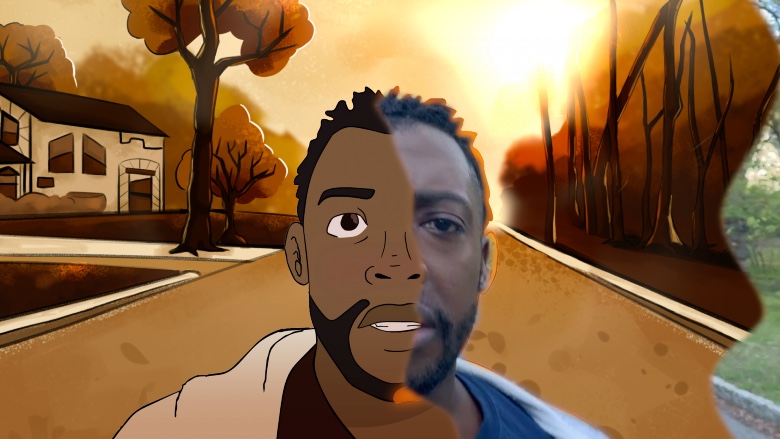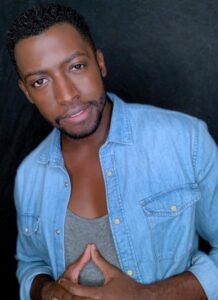
This is the second installment of Below the Line’s look at some of the animated shorts in play for this year’s animation and Academy Awards, the second short being Netflix’s Cops and Robbers, co-directed by Arnon Manor and Timothy Ware-Hill, produced by Lawrence Bender and exec. produced by Jada Pinkett Smith.
It’s based on a poem written by Ware-Hill after watching a video showing the murder of Ahmaud Arbery, a video released on May 5, 2020. Ware-Hill posted a video of himself reciting the poem while jogging, which also quickly went viral. Manor, a prolific visual FX producer and filmmaker, saw Ware-Hill’s video and reached out to animate his work with different animators and artists from all over the world illustrating stanzas of the poem using their own experiences with systematic racism and police brutality, something that absolutely exploded in the summer of 2020. They finished the short by the end of the year despite the film being made completely under COVID protocols.
Last week, Below the Line got on Zoom with the co-directors to talk about making the short.
BTL: This is a very powerful film and very different from other animated shorts that tend to be beautiful images but no words. You also made this entire film during a pandemic, which is quite amazing. How did this come about? Do either of you have a background in animation? I know you normally work in visual FX, Arnon?
Arnon Manor: We always like to start with Tim, as the original kind of instigator in terms of the poem itself, and then I came on board. But yeah, I have a background in animation and visual effects and filmmaking. That’s my background.
Timothy Ware-Hill: Yeah, my only background in animation is that I love it.
Manor: We joke about it, because we say Tim’s dream came true — he’s now an animated character.
BTL: How did you two meet originally?
Ware-Hill: I wrote the poem and released a video of me jogging in my neighborhood, in response to the video release of the killing of Ahmaud Arbery, so that’s kind of how it started. That video itself went viral on social media and Arnon saw the video and reached out to me via Instagram. That was the beginning of our relationship, this idea of taking my poem, dividing the verses and giving them out to animators and VFX artists from all over the world to give their interpretation of each line. That’s kind of how the collaboration began.

BTL: What kind of conversations did you two have as this started in terms of who you wanted to work on each section, in terms of artists and animations house?
Manor: There were two reasons for that. When I saw Timothy’s poem, originally — and it was the day after the Ahmaud Arbery video came out — I had this visceral reaction that I needed to do something. This was three months before George Floyd and everything that happened, so it was slightly before that, and we started immediately. It was so powerful, what can I do to promote and be an ally to this? I saw this idea of animating it, because his performance was so powerful, and the idea of going out to different places was partly creative. I saw this kind of collective of different ideas, but also from a production standpoint, I didn’t want to go out and raise money and have an elongated process. I wanted to just do it very raw and real. I reached out to a few animation places and VFX places that I knew just to get their initial, “Hey, would you be interested in doing this for free?” I put my producer hat on for a second and kind of took away my creative hat and said, “It’s easier to get people to do five to ten seconds of animation for free than to do four minutes.” Once I got a few — and I sent them the link to Tim’s video — after a few months, I got a few okays, I reached out to Timothy again, and I said, “Hey, what do you think?” That was the beginning of the process, and then three weeks later, George Floyd happened, and everything exploded.
BTL: Tim, did you have any thoughts on what you wanted different sections to look or any kind of animation styles that you had seen or work from these artists before.
Ware-Hill: A lot of the artists that were outside of the major VFX studios were animators that we found on Instagram, especially the black animators — a lot of independent, very talented artists. But for all of our artists, we wanted them to stay true to their aesthetic, the way that they choose to do their art, and and they were able to pitch ideas based on the lyric that was chosen, that either they chose what we chose for them. There was a lot of back and forth with them about what each line means specifically to me, versus how they interpreted the line as well, and a lot of historical context. The Black American point of view of our history here in America, there’s a lot of that going back and forth, in order to help create the narrative and to shape the story in the most authentic way.
That was a major part of the process – for the black animators, allowing them to animate from a place of personal experience, and for our allies, our people of color and our white allies, to be able to help tell the story through learning from my personal experiences and the black American experience.
BTL: When you wrote this poem and got it out to people, did you ever think you’d have to explore it and take it apart as much as you had to do to make this short?
Ware-Hill: It’s funny, because I’ve been writing my entire life. I’ve been writing poetry since I was a kid, and even prior to this video, I’ve released other video poems on my social media platform. What I love about poetry, like all art forms, is that even the person who receives the message interprets it a specific way for themselves — everybody’s interpretation isn’t the same. Even through the process of explaining what I meant when I said a certain word or a phrase, when they told me what they got from it, it made me go, “Oh, wow.” There were moments like that even between Arnon and me, where he said, “Oh, I thought this line meant X, Y, and Z,” and I’d go, “Well, it kind of does mean that as well.” That’s the beauty of art, and I think art is always the gateway for people to venture into worlds that they don’t normally explore. I think it’s the bridge that can gap people on opposing sides if they allow themselves to take the journey.
Manor: Just to add to that, we had some really fascinating conversations, and none of our Zoom calls were two minutes long. I think the historical context that Timothy was saying was really important. It wasn’t just “Here’s a line. Go and animate it. Here’s the idea.” We really dissected the history and the why. Again, going back to the time that it was done – Ahmaud Arbery’s video killing came out May 6 or something like that, George Floyd, I think was May 25, and then everything erupted. We were in production on this while the summer of unrest was going on. It was very much in our veins — we were watching it on TV, we were participating in it in a way that we knew how to, which was to create content, to create art, while all this was was going on, hand in hand. It was a really interesting kind of process in that regard.
Ware-Hill: We were creating in real time.

BTL: And also during a pandemic, we should add, because no one was able to all sit in a room together. . I’m not even sure how much contact the two of you even had.
Manor: Well, Timothy and I have never met in real person.
Ware-Hill: Before 2020, I didn’t know what Zoom was. All of these video/virtual chats, and now it’s become the norm. At first, all of us trying to get used to communicating this way felt awkward and strange, but now, it’s like, “Oh, okay, I have another Zoom? Okay, let’s do it.” It was done, as you said, in a pandemic, but the timing of how everything aligned for this piece is pretty phenomenal. Because of platforms like zoom, we were able to communicate with people from all over the world. We had animators from Vancouver to Toronto, L.A. to New York, down in Alabama, Mississippi, Georgia, Louisiana — we got all the way down to South America and Uruguay, Baltimore to Germany, London and France. It become a global effort to put this together during this global pandemic. There’s beauty that has come out of both the tragedies of the Ahmauds, the George Floyds and the Breanna Taylors, as well as the lives of those affected by the Coronavirus.
Manor: That was the intent, I think, was not just to have one specific voice. Timothy and I spoke about this very intently and ongoing. It shouldn’t be just the voice of black Americans. Obviously, the majority of the segments were created by black artists and animators, but again, the intent was — and we talk about it all the time – it’s about allyship. It’s about no change can happen if there’s not an allyship for the cause. If it’s just the African-American or black American issue, and we and myself as a white guy can’t involve myself in that, then the cause is lessened, or at least the responses is lessened. That was a big factor of what we were saying is that, in order to make change, we all have to be in it together. Even though, the whole issue of Black Lives Matter versus “All lives matter,” but THIS is about Black Lives Matter. We even had a few artists — if you recall, Timothy — where they were kind of going down the line of “all lives matter” Yeah, of course, we understand that, but again, this is very much focused on this issue, as we know, which was a big political debate and still is an ongoing debate. That was a big factor of our approach.
BTL: Doing post on this movie must have been tough, since you have all these disparate segments to edit together. Were you able to have any time sitting in a room with the editor or was that all virtual as well?
Manor: Everything was remote, from the animation process to the post-production, editing, sound, music. Literally everything was was remote, using a variety of Zoom, obviously, for meetings, but it was a couple of other online tech services that we used just in terms of communicating. The hardest part was actually sound and listening to a mix, because we brought on some amazing sound FX editors – Greg Hedgepath was one of them, Steve Ticknor. Ezra Dweck was our sound mixer. It’s like if I listen to it on these [points to earbuds] and Timothy on his – hearing the subtleties of that was tough, but that was part of the COVID process.
Ware-Hill: Even our final mix, we were able to get onto a soundstage — Arnon in LA and myself in New York — and the studios were able to connect remotely, so we got to hear it in a 5:1 surround sound setting, jut to continue to work the mix and balance. We got to hear it in, in a five one surround sound setting, to just to continue to work and mix and balance in it. It was an exciting and interesting process, even through the challenges, but we finally got it to a place that we were very pleased with.
BTL: How did Jada Pinkett Smith get involved? Had she seen Tim’s poem and reached out?
Ware-Hill: Yeah, it was a multi-step process that went faster than the speed of sound. Lawrence Bender, one of our main producers on this piece, and for your followers who may not know who Lawrence is, he produced a lot of Quentin Tarantino’s earlier films like Reservoir Dogs, Kill Bill and Pulp Fiction. He’s a dear friend and mentor of mine. I shared with him one of our works-in-progress before the piece was even completed. He was moved by it and said, “I have to be a part of this.” It was through Lawrence’s excitement, he pushed out the piece to different people in the industry that he had connections with. One of them happened to be connected to Jada as well, so it made its way to Jada that way. She saw it and was moved by it, and I’m sure because of her own personal experiences of being a black woman and a mother to black children. Having her on this has been a true blessing, because her reach has allowed more eyes to come upon our film. We’re also grateful for Netflix, which is the perfect partner and distributor for this short.
Manor: I think it’s interesting, Timothy, because we talked about the path of progression. Your initial video had its viral moment, then we created an animated version of that in order to enhance that, then Laurence came on board, which enhanced it even more, then Jada came on board, and then Netflix – it’s kind of a snowball effect, which has been really amazing. When we started off, the intent was just to create something powerful and artistic and creative. Animation was the medium that we thought would push it further. Had we thought back then that this would be released on Netflix to 200 million people in 100 or 200 countries, I don’t think we would have imagined that. Again, it’s all about just spreading the message of what we’re portraying in the video.
Ware-Hill: I would have to say that the most beautiful part about this is that — as Arnon mentioned earlier — not a single person got paid for this project. Everyone volunteered their time and artistry, because they believed in the message. From the major Hollywood VFX studios to the single, independent artists working from home, not a single dollar passed fingers. The funds that were given from Netflix, Arnon and I have dedicated to donate 100% of those proceeds to black charitable organizations.
You can watch Cops and Robbers on Netflix.
All photos courtesy of Netflix.





